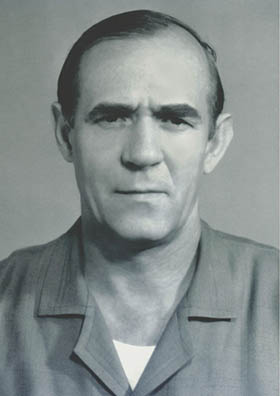The revolutionary movement in Alexandrovsk
Leaders of the Proletariat
Pictures of the leaders of the proletariat Lenin, Karl Marx, and Friedrich Engels were required in Soviet art. Such pictures were subject of special importance.
Only a few sketches, old photographs and two watercolor drawings of Lenin and Marx are preserved from the works of Pavel Redin, devoted to this topic.
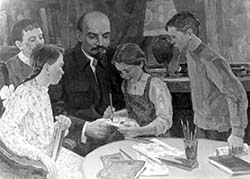
Vladimir Lenin and children
Oil on canvas
The 1950s
19½ x 27½ in.
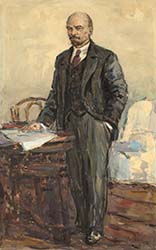
Vladimir Lenin
Gouache on paper
1963
19½ x 11¾ in.
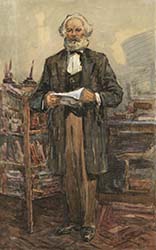
Karl Marx
Gouache on paper
1963
19½ x 11¾ in.
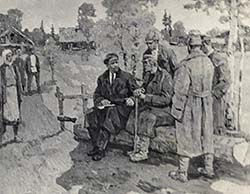
Lenin's conversation to the peasants
Oil on canvas
The 1950s
21½ x 27½ in.
Forerunners of the socialist revolution
At the end of the 19th century and the beginning of the 20th century, social tension increased in society. The country has come to a political crisis. Individual worker strikes, discontent with the social structure of society, even an attempt on the tsar were a manifestation of peoples’ anger.
By the 1905, the situation has escalated. Peoples’ unrest and spontaneous uprisings swept the whole country. Armed riots began in big cities. The period of 1905-1907 was named the bourgeois-democratic revolution. This revolution did not achieve major changes in the country. Cruel punitive measures by the authorities suppressed peoples' protest. The bourgeois revolution itself was only an intermediate stage on the way to more global and serious events - the Socialist revolution. But this happened only 10 years later - in 1917.
The episodes from the life of Aleksandrovsk (Zaporozhye) of that time were reflected in the paintings by Pavel Redin: Andrew Zhelyabov's unsuccessful train bombing attempt where the tsar was; the historic barricade fight at the South Station of Aleksandrovsk; scenes of brutal suppression by the authorities of any protest or dissent.
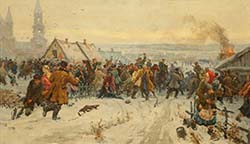
Punitive detachment
in Fedorovka village, December 1905
Oil on canvas
The 1950s
23½ x 39½ in.
This painting is in the collection of Zaporozhye
Regional History Museum
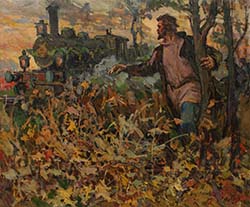
Andrew Zhelyabov
(The attempt on Alexander II,
November 18, 1879 in Alexandrovsk)
Oil on canvas
1982
31½ x 39½ in.
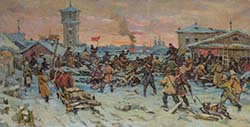
Construction of the barricades by workers
of the railway workshop of Catherine station
in town Aleksandrovsk (Zaporozhye).
Morning of December 13, 1905
Oil on canvas
1962
19½ x 37½ in.
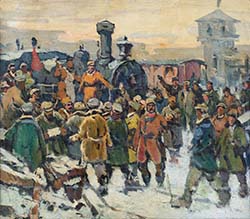
Revolt of workers
of railway workshops
in Alexandrovsk (Zaporozhye)
Oil on canvas
1962
15 x 17 in.
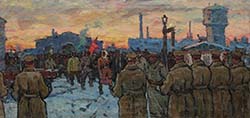
1905 year in Alexandrovsk
Oil on canvas
1961
31½ x 61 in.
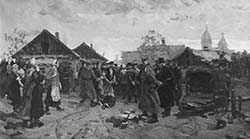
Search
Oil on canvas
1967
21½ x 39½ in.
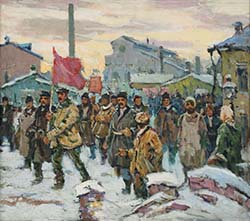
To the barricades!
Oil on canvas
1962
15 x 17 in.
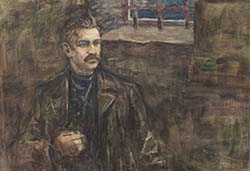
The revolutionary Ivan Babushkin
in Ekaterinoslav prison, 1902
Gouache on paper
1956-1957
17¾ x 25½ in.
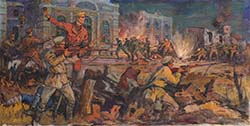
The fight at the barricades
near the South Station
of Aleksandrovsk (Zaporozhye).
December 14, 1905
Gouache on paper
1956-1957
13¾ x 25½ in.
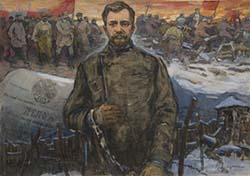
The Chairman of the strike committee
of Aleksandrovsk V.L. Vasiliev
(arrested by the police in the building
of the South Railway Station on December 13, 1905
and condemned by the tsar's court)
Gouache on paper
1956-1957
19½ x 27½ in.
Revolutionary events in Zaporozhye
In 1917, two revolutions occurred in Russia that established Soviet power. The early years of the establishment of the power of the Soviets were extremely difficult. In the country devastation reigned. Supporters of the previous regime opposed the new government in every way and staged an attempt on the Bolsheviks. There were protest movements (one of the most famous - the Makhnovist movement).
In 1918, a civil war broke out in the country that lasted until 1922.
The brightest moments from the life of post-revolutionary Aleksandrovsk (Zaporozhye) are depicted in a series of paintings by Pavel Redin.
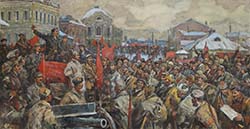
The proclamation of Soviet authority
in Alexandrovsk (Zaporozhye).
January, 1918
Gouache on paper
1956-1957
19½ x 39½ in.
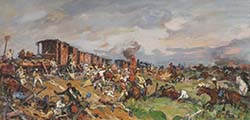
The repulse of the attack. Assault of
Wrangel's army on train with food.
September, 1920
Gouache on paper
1956-1957
13¾ x 29½ in.
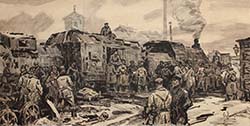
The arrival of the armored train
at station Catherine
of town Alexandrovsk (Zaporozhye)
Gouache on paper
1956-1957
13¾ x 25½ in.

The death of Alexander Angolenko
in the wooded areas of Dnieper in 1920
Gouache on paper
1956-1957
10 x 27½ in.
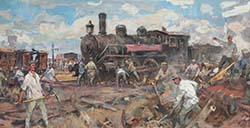
Communist Saturday
of workers of railway depot
Gouache on paper
1956-1957
13¾ x 25½ in.
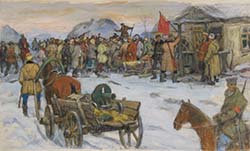
The defeat of the Makhnovist movement
and the establishment of Soviet authority
in the villages of Zaporozhye region.
(November, 1920 - June, 1921)
Gouache on paper
1956-1957
15¾ x 25½ in.
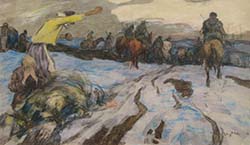
The enemy passed
Gouache on paper
1956-1957
15¾ x 25½ in.
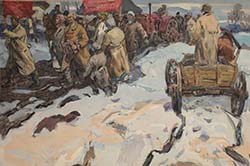
Collectivization in the countryside.
The first tractor
Gouache on paper
1956-1957
17¾ x 27½ in.
Wrangel in Zaporozhye
In 1920, a fierce civil war between the Red army and the White army was going on in the country. Wrangel was the commander-in-chief of the White army in the Crimea. In June 1920, Wrangel's troops repelled the Red Army’s attack on the Crimea, launched a counterattack and seized part of the Northern Azov region.
But this success of Wrangel did not last long. Already in October 1920, after fierce fighting with the Red Army, Wrangel's troops retreated back to the Crimea. And in early November, after the Reds, under the command of Frunze, broke into the Crimea, a mass evacuation of the White forces from the Crimea began on ships.
One of the episodes of hot October 1920 was reflected in the works of Pavel Redin. The attack of the detachment of the Wrangel army on a train with food was sealed in the artist's picture and a small diorama. Unfortunately, the location of this diorama is unknown. There is only an old photo.
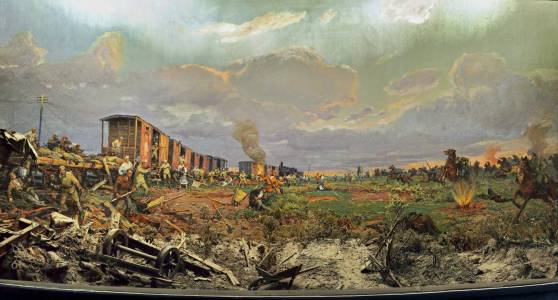
The repulse of the attack
Assault of Wrangel's army on train with food
September, 1920
Diorama
1965-1966
Large, serious works of the artist on the theme of the revolutionary movement in the Zaporozhye region are paintings: "The proclamation of Soviet power in the city of Aleksandrovsk" and "The creation of the Komsomol organization in the city of Aleksandrovsk. Before writing these paintings, the artist not only studied historical archival materials, but also spoke with contemporaries and direct participants in those events.
The newspaper Industrial Zaporozhye published an article entitled “The Chronicle of the Native City” devoted to the work of Pavel Redin, where the working process of creating those canvases was described. You can read this article here.
The proclamation of Soviet power in the city of Aleksandrovsk
In 1917 two revolutions took place in Russia: the February (bourgeois) and the October (socialist) revolutions. After the February Revolution, an unstable dual power arose in Petrograd — the Provisional Government and the Petrograd Soviet. In Kiev, a third political force was formed - the Central Rada.
After the October Socialist Revolution and the overthrow of the Provisional Government in Kiev, the Central Rada adopted the Third Universal and proclaimed the creation of the Ukrainian People's Republic. But a month later a conflict occurred between the Ukrainian Central Rada and the Council of People's Commissars of Soviet Russia. The policy of the Central Rada was declared counter-revolutionary. By the end of 1917, power in Aleksandrovsk was controlled by armed units of the Central Rada, free Cossacks, and Haydamaks. But in the city, the Russian Social Democratic Labor Party of Bolsheviks (RSDLPb) operated clandestinely.
The first battles for the power of the Soviets in Aleksandrovsk began on the night of December 12 and lasted until December 15, 1917. The forces in the fight against the White Guards and the armed units of the Central Rada were unequal and the Bolsheviks had to retreat. On December 27, 1917, an armed uprising took place in the Yekaterinoslav provincial center (Dnipropetrovsk), which ended two days later with victory and the establishment of Soviet power. This event inspired the Bolsheviks to rout the counterrevolution in Aleksandrovsk.
On the night of January 1 to 2, 1918, an armed uprising began in Aleksandrovsk. Baltic sailors and Red Guards arrived to help the rebels. An armored train - a formidable weapon of those times- arrived at the South Station (Zaporozhye Station 1) for fire support of the Red detachments. By the morning of January 2, part of the Central Rada military detachments retreated beyond the Dnieper, and some into the swamps of the Great Meadow. Aleksandrovsk came under the power of the Bolsheviks.
The painting by Pavel Redin "The proclamation of Soviet power in the city of Aleksandrovsk (Zaporozhye), January 1918” depicted the events of that far January 1918: morning, the central city square near the cathedral. Soldiers and sailors, who at night fought hard against the Haidamaks, gathered at a spontaneous rally. T. M. Mikhelovich, the future head of the City Council of Workers' Deputies, appears before the people and proclaims in the city Soviet power.
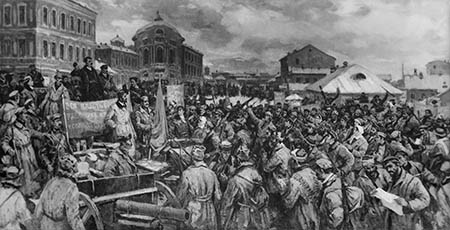
The proclamation of Soviet authority in Alexandrovsk (Zaporozhye). January, 1918
Oil on canvas
1977
31½ x 61 in.
Creation of the Komsomol organization in the city of Aleksandrovsk
After the socialist revolution of 1917 and the establishment of Soviet power, the need to create a youth structure that would unite the revolutionary youth became obvious. On October 29, 1918, the First All-Russian Congress of Workers 'and Peasants' Youth Unions was held, at which the creation of the Russian Communist Youth Union was proclaimed. After that, Komsomol organizations were created in the cities of the country. Among the first members of the Komsomol were many young workers and soldiers who joined the ranks of the Komsomol on the fronts of the civil war.
In the city of Aleksandrovsk (Zaporozhye) the Komsomol organization was created in March, 1919. The solemn conference dedicated to this event was held in the building of the people's house (later - Lenin cinema on Svoboda Square). A well-known Russian revolutionary and diplomat, Alexandra Mikhailovna Kollontai, came to participate in this conference. At that time she was the head of the political department of the 1st Zadneprovskaya Ukrainian Soviet Division.
This an important event in the history of the city and the speech of A.M. Kollontai to the first Komsomol members was captured on the canvas by Pavel Redin "Creation of Komsomol organization in Aleksandrovsk (Zaporozhye), March 1919."
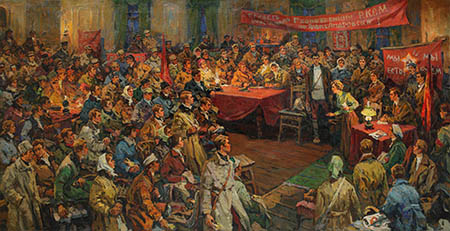
Establishment of the Komsomol organization in Alexandrovsk (Zaporozhye). March, 1919
Oil on canvas
1977
31½ x 61 in.
